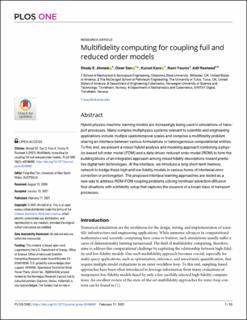| dc.contributor.author | Ahmed, Shady E | |
| dc.contributor.author | San, Omer | |
| dc.contributor.author | Kara, Kursat | |
| dc.contributor.author | Younis, Rami | |
| dc.contributor.author | Rasheed, Adil | |
| dc.date.accessioned | 2022-05-31T13:32:32Z | |
| dc.date.available | 2022-05-31T13:32:32Z | |
| dc.date.created | 2021-02-03T00:21:45Z | |
| dc.date.issued | 2021 | |
| dc.identifier.citation | PLOS ONE. 2021, 16 (2), e0246092. | en_US |
| dc.identifier.issn | 1932-6203 | |
| dc.identifier.uri | https://hdl.handle.net/11250/2997081 | |
| dc.description.abstract | Hybrid physics-machine learning models are increasingly being used in simulations of transport processes. Many complex multiphysics systems relevant to scientific and engineering applications include multiple spatiotemporal scales and comprise a multifidelity problem sharing an interface between various formulations or heterogeneous computational entities. To this end, we present a robust hybrid analysis and modeling approach combining a physics-based full order model (FOM) and a data-driven reduced order model (ROM) to form the building blocks of an integrated approach among mixed fidelity descriptions toward predictive digital twin technologies. At the interface, we introduce a long short-term memory network to bridge these high and low-fidelity models in various forms of interfacial error correction or prolongation. The proposed interface learning approaches are tested as a new way to address ROM-FOM coupling problems solving nonlinear advection-diffusion flow situations with a bifidelity setup that captures the essence of a broad class of transport processes. | en_US |
| dc.language.iso | eng | en_US |
| dc.publisher | PLOS | en_US |
| dc.rights | Navngivelse 4.0 Internasjonal | * |
| dc.rights.uri | http://creativecommons.org/licenses/by/4.0/deed.no | * |
| dc.title | Multifidelity computing for coupling full and reduced order models | en_US |
| dc.type | Peer reviewed | en_US |
| dc.type | Journal article | en_US |
| dc.description.version | publishedVersion | en_US |
| dc.rights.holder | © 2021 Ahmed et al. | en_US |
| dc.source.pagenumber | 20 | en_US |
| dc.source.volume | 16 | en_US |
| dc.source.journal | PLOS ONE | en_US |
| dc.source.issue | 2 | en_US |
| dc.identifier.doi | 10.1371/journal.pone.0246092 | |
| dc.identifier.cristin | 1886130 | |
| dc.relation.project | Norges forskningsråd: 268044 | en_US |
| dc.source.articlenumber | e0246092 | en_US |
| cristin.ispublished | true | |
| cristin.fulltext | original | |
| cristin.qualitycode | 1 | |

